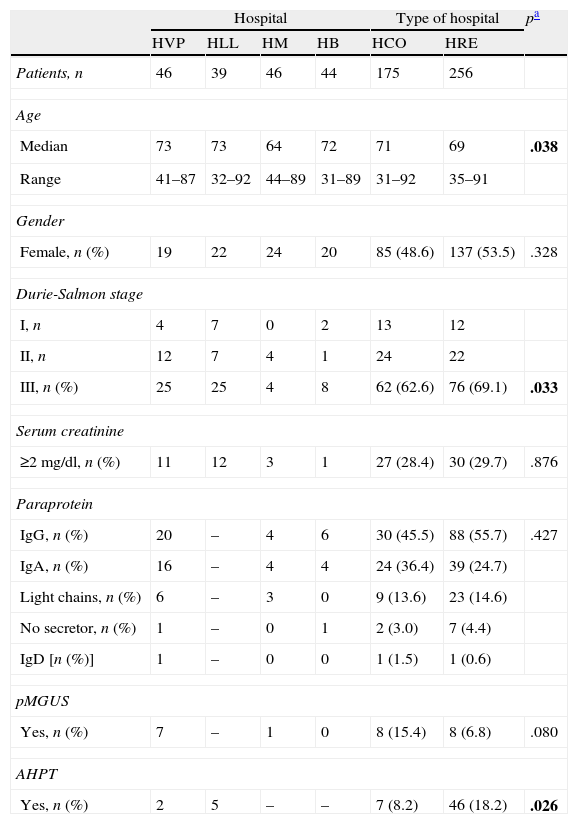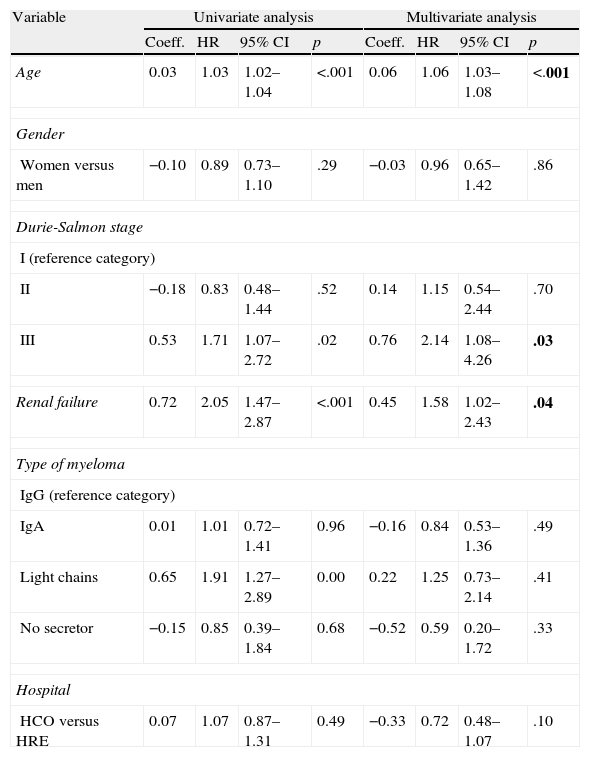To analyze the impact of the type of hospital in overall survival of multiple myeloma patients.
Patients and methodA survival analysis was performed of all patients (n=431) diagnosed in 5 public hospitals (4 community hospitals and one university hospital) during the period 1993–2006.
ResultsPatients attended to in community hospitals differ significantly from those seen in the university hospital in the following variables: mean age (70 years [31–92] versus 67.9 (35–91), p=.038); percentage of stage iii patients (62.6% versus 69.1%, p=.033), and percentage of patients who had autologous stem cell transplant (8.2% versus 18.2%, p=.026). The variables associated with mortality in the multivariate analysis were age (p<.001), stage (iii versus i; p=.03) and renal failure (p=.04). The type of hospital did not reach statistical significance (hazard ratio of 0.72 (95% confidence interval 0.48–1.07), p=.1].
ConclusionsThe type of hospital is not significantly associated with mortality in multiple myeloma patients. These data support our current model of health care, in which the community hospitals are responsible for the primary care of these patients, in a coordinated work with the university hospital.
Analizar el impacto del tipo de hospital en la supervivencia global de los pacientes con mieloma múltiple.
Pacientes y métodoAnálisis de supervivencia de todos los pacientes (n=431) diagnosticados en 5 hospitales públicos (4 comarcales y uno universitario), durante el periodo 1993–2006.
ResultadosLos pacientes atendidos en los hospitales comarcales difieren significativamente de los atendidos en el hospital de referencia en las siguientes variables: edad media (70 años [rango 31–92] versus 67,9 [rango 35–91]; p=0,038), porcentaje de pacientes en estadio iii (62,6 versus 69,1%; p=0,033), y porcentaje de pacientes sometidos a trasplante autólogo de médula ósea (8,2 versus 18,2%; p=0,026). En el análisis multivariante, las variables asociadas de forma significativa con la mortalidad fueron la edad (p<0,001), el estadio (iii respecto a i; p=0,03) y la insuficiencia renal (p=0,04). El tipo de hospital no alcanzó significación estadística (hazard ratio de 0,72 [intervalo de confianza al 95% 0,48–1,07], p=0,1).
ConclusionesEl tipo de hospital no se asocia de forma significativa con la mortalidad en pacientes con mieloma múltiple. Estos datos apoyan el actual modelo de atención a estos pacientes, en el que los hospitales comarcales son responsables de su manejo primario, de forma coordinada con el hospital universitario.
Article
Diríjase desde aquí a la web de la >>>FESEMI<<< e inicie sesión mediante el formulario que se encuentra en la barra superior, pulsando sobre el candado.

Una vez autentificado, en la misma web de FESEMI, en el menú superior, elija la opción deseada.

>>>FESEMI<<<







